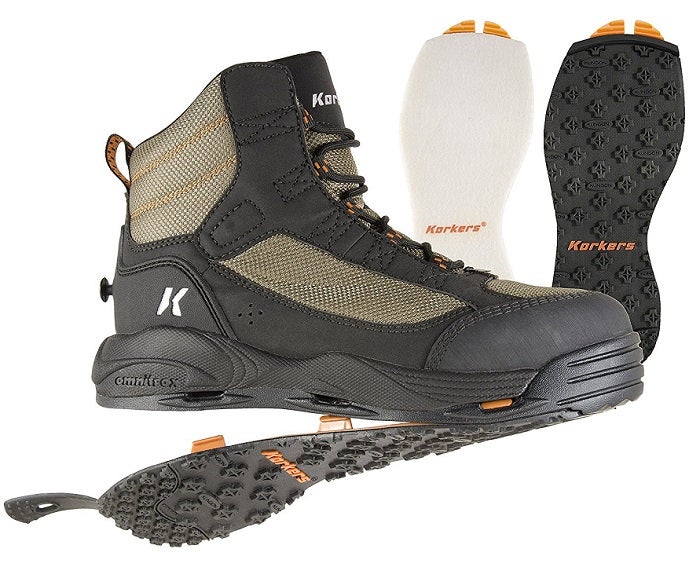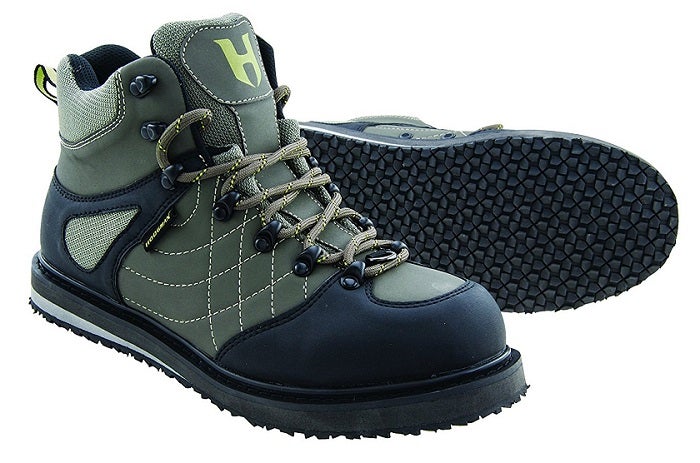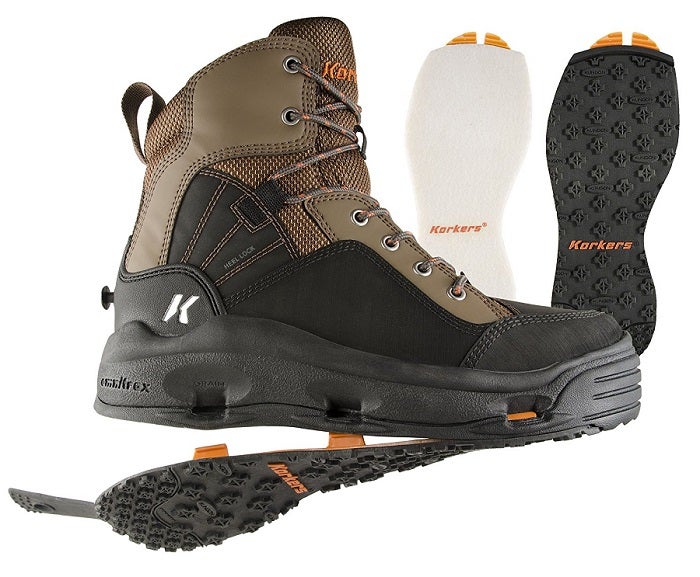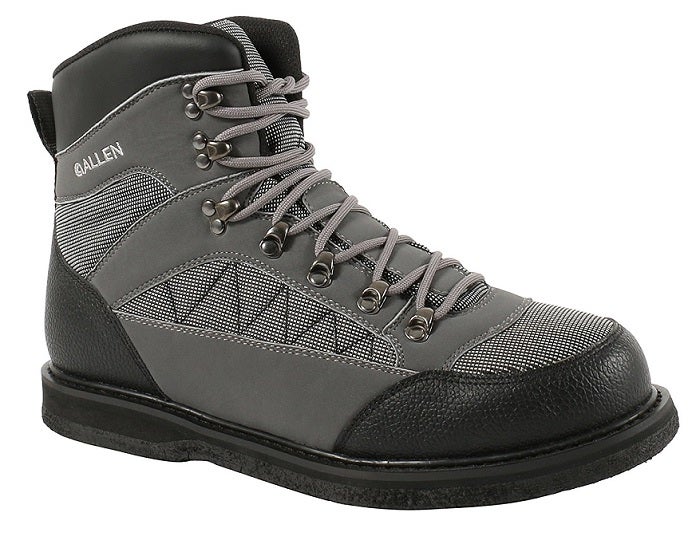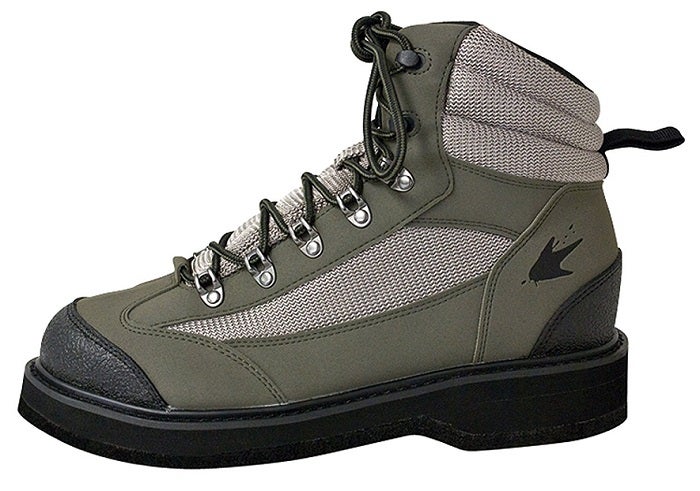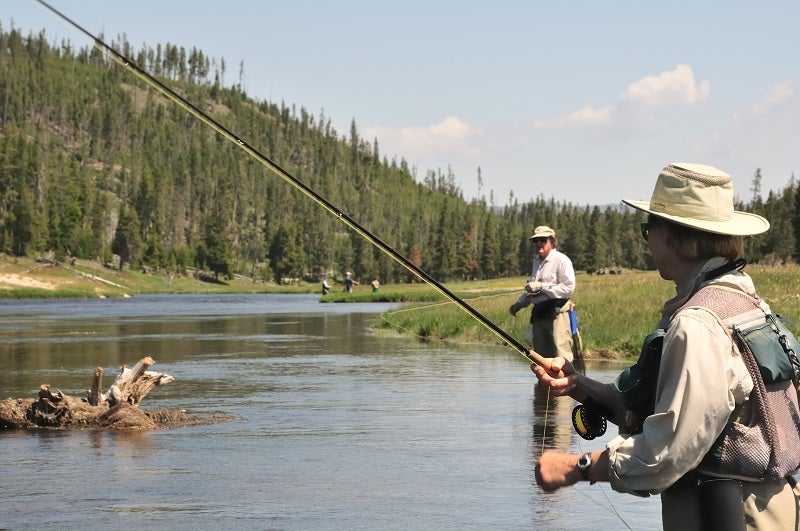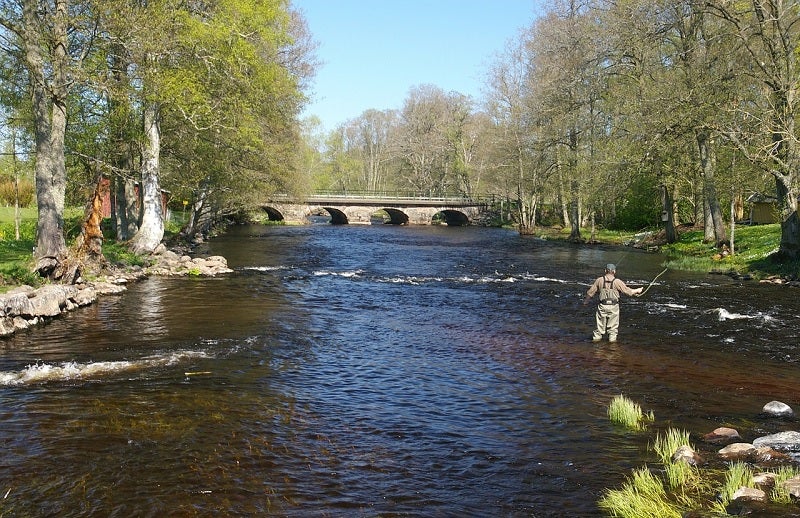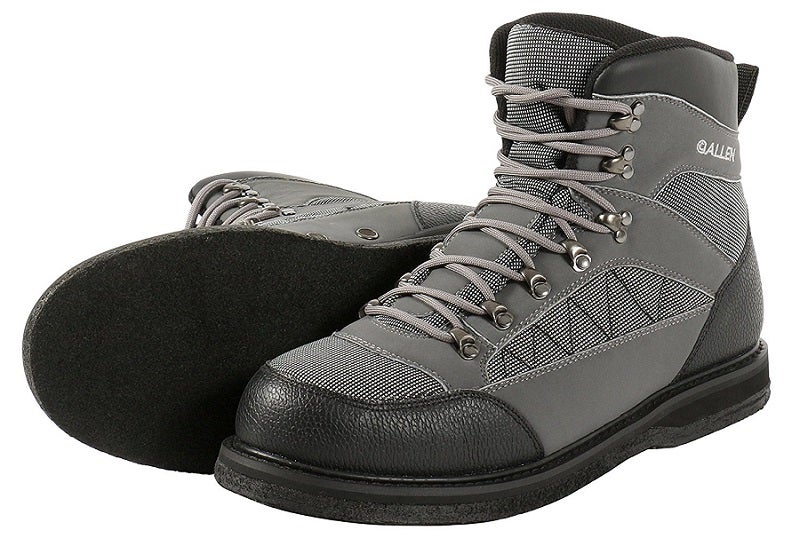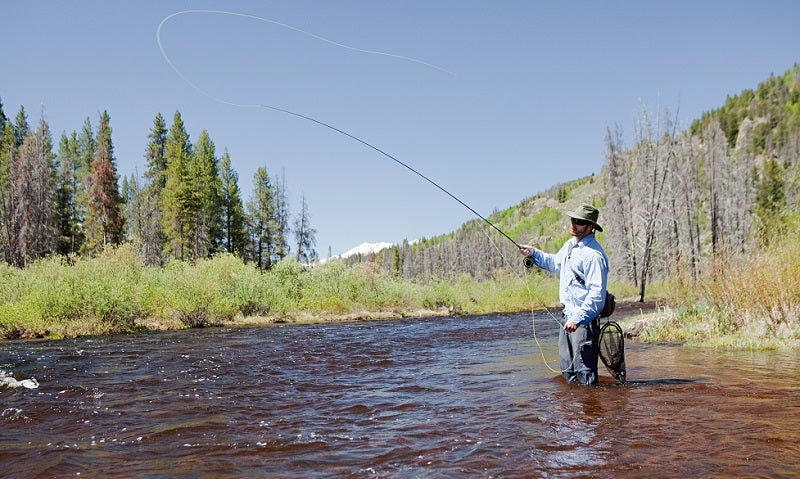
Our Editors independently research, test, and rate what we feel are the best products. We use affiliate links and may receive a small commission on purchases.
Choosing the best wading boots for fly fishing isn’t always as easy as picking out tennis shoes. There are more features and functions at play in your ordinary wading boot.
If these boots are going to get you to the rivers and streams where you can land the fish you’re looking for, you’ll demand top notch.
Good wading boots share a lot of commonalities with other footwear, but we need them to handle wet, slippery environments.
That’s why I’m going to walk you through what you need to know to pick out your next wading boots. By the time you’re done with this article you’ll be ready to pick out your next pair of fly fishing wading boots.
Best Wading Boots
For more of my fishing gear recommendations, have a look through these popular Outside Pursuits guide links: Fly Reels, Fly Rods, Vests, Waders.
Quick Answer: The 5 Best Rated Wading Boots For 2021
- Korkers Greenback Wading Boot
- Hodgman H3 Wading Boot
- Korkers BuckSkin Wading Boot
- Allen Company Granite River Wading Boots
- Frogg Toggs Hellbender Felt Sole Wading Shoe
Now I’ll suggest a handful of the most popular, top rated wading boots available today.
Wading Boots Reviews
#1 Korkers Greenback Wading Boot
- OmniTrax 3.0 Interchangeable Sole System
- Plain Felt AND Kling-On Sticky Rubber Soles Included
- Sizes 7 – 14
- Water drainage system
Korkers earns the top spot on our list of best wading boots for fly fishing for one main reason. There’s no need to decide if you want rubber or felt soles. These boots have both!
So, rubber soles are great for some situations. Felt soles are great for other situations. What’s to be done?
Easy! Just go with the Korkers changeable sole boot. These boots have a swapping system where the entire sole can be switched.
Rubber soles some days, felt soles on other days. I love that this also reduces the decision stress of choosing one or the other.
On top of the ingenuity of this interchangeable system, these boots are some of the highest rated wading boots we’ve checked out.
Hydrophobic materials and water channel construction help to shed extra water weight when you get out of the river. Wet boots are heavy boots, but not if they dump all that extra water right back into the river.
Best For: Those who don’t know which sole to get – have both felt and rubber in one boot!
#2 Hodgman H3 Wading Boot (Felt)
- Rubber toe cap
- Felt sole
- Lightweight shock absorbing EVA mid sole
- Ankle-high cuffs
Speaking of top rated wading boots, the Hodgman H3 is a lower profile felt sole boot perfect for high traction.
The fit is a little less than a hiking boot and a little more than a tennis shoe. Somewhere between stiff and flexible.
These are the best waders if you’re looking for the lowest profile and most flexible boot. This means they’ll be lightweight and won’t drag you down.
Plus they feature tons of drainage near the instep where water can escape as you leave the river.
The felt soles make a perfect match for these boots because you’ll have a good bit of tactile feel left. The smaller boot will be a bit more pliable than larger stiff boots and the felt sole contours well to submerged objects.
It’s worth noting that the H3 is also available in rubber sole if that strikes your fancy. It’s up to you!
I will say that the speed laces at the top of the cuff and the rubber toe cap are good additions. Speed laces just make it quick and easy to get the boot on and off.
While the rubber toe cap protects the boot, and your toe, from submerged objects.
Best For: A lighter, smaller felt soled wading boot when traction is key.
#3 Korkers BuckSkin Wading Boot
- Full size wading boot
- Includes Plain Felt AND Kling-On Sticky Rubber Soles
- Rubberized anti-abrasion synthetic material
- Water drainage channels
If the Hodgman H3 is the smallest wading boot on our list, the Korkers BuckSkin is by far the largest. This full-size boot is rugged, durable, and encapsulates the entire foot and ankle like a full size hiking boot.
One less obvious feature of the BuckSkin boot is the incredible drainage capabilities. These boots have channels molded into the insoles which allow water to drain directly out of the boot.
Many boots don’t have nearly enough drainage, or it’s placed in silly positions.
These drainage channels are ideally located.
With the full-size over the ankle design of these boots, they make good choices when river bottoms are particularly treacherous.
The large rubber toe cap protects your toes while the boot itself protects your legs right up over the ankles.
One thing I would have liked to see on these boots are speed laces at the top. As it is they feature traditional lacing all the way to the top of the boot which makes entry and exit sometimes tricky.
Like the other Korkers boots, these feature interchangeable felt and rubber soles which is a major bonus. These may be the best breathable waders on our list.
Best For: Full foot and ankle protection in nasty waters.
#4 Allen Company Granite River Wading Boots
- Felt sole
- Ankle-high design
- Lightweight EVA midsole
- Speed lacing
Ready for a felt soled wading boot that won’t break the bank?
Yeah, I know some of the other options on our list aren’t the most affordable. Let’s take a look at an option for those with a tight pocketbook.
These ankle high boots are a mid sized boot for wading in conditions where traction is king. Remember, felt isn’t ideal for hiking so be sure that you’ll be getting in the water with very little walking.
I do have to admit, these are one of the few boots that use speed lacing on the uppers. Beats me why other makes aren’t using speed lacing but I will say it earns a +1 in my book!
One improvement I would have liked to see in these boots is a better drainage system. The drain holes are located a bit too high to effectively drain all the water.
But, is that a major failure on a relatively affordable boot? I don’t think so.
Best For: High traction soles when there is little distance from the car to the river.
#5 Frogg Toggs Hellbender
- Mesh upper with PVC outskin
- Felt sole
- Over-the-ankle design
- Speed lacing on uppers
Quite frankly, up until this moment I was unaware Frogg Toggs made anything but high quality, affordable rainwear. Apparently they also make great fly fishing wading boots too – who knew!
These boots have a felt sole that sits on a sturdy platform. When rocks are sharp or irregular, thick soles and felt help absorb and contour to the river bottom.
That’s exactly what Frogg Toggs has done by making the soles of this boot super thick.
Remember that the felt soles are permanent. Like any felt sole wading shoe it’s important to remember that some districts don’t allow felt because it has a chance to transport invasive species.
Check the areas you’ll be fishing before you go!
Some users complain about the durability of the sole and the rivets used in the laces. I looked into this and found it to be inconsistent amongst reviewers so it’s hard to say.
Like any budget product, you may get what you pay for. The majority of users, however, are very happy with these wading boots.
Best For: Your looking for the best budget wading boots that make a good option for beginners or those on a budget.
How to Choose the Best Wading Boots – Buyers Guide
- Deciding on a Sole
- Sizing Your Wading Boots
- Lacing
- Hiking Style vs Wading Style
- Regulations and Legal Issues
- Final Thoughts
Deciding on a Sole
Before any other decision is being made, you’ll have to choose the sole material. Unlike most shoes and boots, wading boots have a couple of distinct sole options.
hanks to the unique and slippery demands of traction in river conditions rubber and felt sole are the two options of choice.
Rubber Soles
Are a lot like your traditional shoes and boots of everyday use. In wading boots these rubber soles typically have larger, more aggressive tread patterns than standard shoes.
When manufacturers create soles for wading boots they tend to be made from softer, more sticky rubber. This all helps to create traction in the water on slimy surfaces.
Rubber soles are good if you need to hike long distances to get to the river. Or if you spend a lot of time throughout the day going from the river to your car, or into the cabin / store. Rubber retains less dirt and water compared to felt.
Rubber soles also hold up better over the long term when hiking is involved.
Felt Soles
Felt is the second option. While you won’t find traditional shoes made with felt soles, felt actually creates amazing grip in the river. Felt soled boots are made with a very thick layer of felt instead of rubber.
This felt does a great job of molding and compressing around the shapes of rocks in the river and improves overall traction dramatically.
Felt will eventually wear out, however most name brand felt soled boots have some way of replacing the felt when it does wear. If you’re concerned about eventually replacing the felt on a felt boot, make sure to research how your particular boot is maintained in that way.
Studded Soles
Are rarer but still effective in some cases. These rubber or felted boots have little metal spikes built in. These spikes can dig in and improve traction in even the nastiest conditions.
Usually waders only choose these options when water is particularly fast, strong, or dangerously slippery.
Sizing Your Wading Boots
Like a good hunting boot, your wading boots need to be sized up a bit. This can be tricky when manufacturers already have different sizes. However, as a rule, you’ll want a wading boot that’s about a half size bigger than your standard hiking boot size.
Why go bigger? Because water is cold! Especially in early and late season wading when streams can be infused with ice melt water temperatures can be dangerously cold to those little toes!
By sizing your boot up a bit you’ll have room for wading socks and insulated socks that can keep your feet warm. Trust me, you won’t be in the river long before your toes go numb in the early spring unless you’re wearing some warm socks!
Be careful of going overboard though. Boots that are sloppily large can be hard to control and may cause you to lose your balance in the water.
Lacing Options
When it comes to lacing we essentially get 4 main options:
- Traditional
- Velcro
- BOA Lacing
- Speed Laces
Traditional Lacing
Is common on most wading boots. These feature eyelets all the way from the toe to the cuff. There’s nothing wrong with traditional lacing but, as we all know, there are a few drawbacks. It can be hard to loosen the laces to slip the foot in, and knots come untied.
Velcro
Is sometimes added around the boot cuff. In rare cases these velcro additions are used to help reinforce traditional lacing. Having this feature can prevent the boot from loosening over time.
BOA Lacing
A newer lacing system. You’ve probably seen them before. These dial laces are a small, sturdy cord, attached to a rotating ratchet mechanism at the top of the boot. Simply spin the ratchet with two fingers and tighten up the boot. It’s guaranteed to stay tight all day.
BOA laces are effective but expensive. Many will have the, “It doesn’t do anything I can’t do with a regular old shoelace,” mentality. For some, the BOA system is quick, effective, and efficient.
Speed Laces
Are usually combined with traditional lacing. Speed laces are simply the hooks on the top half of most boots that shoelaces loop under. This makes it easy to open up the tongue of the boot for entry and exit.
Any wading boot with traditional laces should have speed laces on the top of the ankle. Otherwise it’s just a pain in the butt to get them on and off each time.
Hiking Style vs Wading Style
Nope, not talking about fashion here. Instead what we’re talking about is picking out the right style of wading boot. So, what styles are there?
Essentially you’ve got two big splits in the wading boot world. One type of boot is meant to handle some walking and hiking. The other type of boot is meant to get right in the river and get to work.
Hiking Style – boots tend to feature rubber soles. They’re usually stiffer and may offer some advanced ankle support. These boots are meant to handle a blend of activities from the car, down the trail, and into the water.
Wading Style – boots (just my name for them) are usually more flexible. They are meant to spend almost all their time in the water. They usually will have felt soles and may be more soft and flexible than a hiking style boot.
Of course, there are also tons of wading boots that run the spectrum between hiking style and wading style. What’s really the most important is that you consider the type of fishing you’ll be doing and the locations you’ll visit.
Then choose the wading boot that matches your needs!
Regulations and Legal Issues
Invasive species are a real problem in many areas. Taking water from one water source to another can introduce harmful pests into areas they don’t belong. Regulations and legislation is in place to prevent this and keep our natural resources in good shape for future users.
Felt sole wading boots are illegal in some areas for this reason. Felt soles have the potential to trap and carry invasive species. Be sure to check local regulations before you go.
Getting a ticket is expensive and the DNR can revoke your license. Not to mention you don’t want to be responsible for wiping out an entire habitat, do you?
Outside Pursuits Overview
On our list you’ll find wading boots from big name brands and small manufacturers. I’ve tried to include everything from rubber soles to felt soles and across a broad price range.
No matter your needs or your price range, there should be a fly fishing wading boot on our list that makes a great option for you.
When it’s time to pick up your next pair of fly fishing wading boots, be sure to reread the “how to choose” section. Think about what types of rivers you’ll be fishing and what situation you’ll have.
Will you hike to the river?
Or will you get out of the car and get right in the water?
There’s nothing wrong with starting at an affordable boot and then upgrading as you go. Sometimes we all have the tendency to go for the top shelf product right off the bat. It’s okay to start small.
Most of all, just remember that the best fly fishing wading boot for you is going to be different than others. Make your own call, and enjoy landing those fish!
How We Researched
To come up with the top wading boots we researched a variety of sources for reviews such as REI, Dicks Sporting Goods and Bass Pro Shops along with our own personal experience.
We also consulted online magazines for product research and reviews to get as much unbiased information as we could. To help weed out fake reviews we used Fakespot.com to make sure we only looked at genuine reviews.
With so much quality gear available, we had to narrow it down based on what we felt were the best options for the price. The author, Casey Fiedler has been an avid fisherman for decades and leads fishing trips into the backcountry.
To help narrow down the selection our authors used their personal experience along with recommendations from charter captains and tour guides.
After extensive research, we came up with our list to help you choose the right one for you.
Sources
I hope this guide was helpful for finding the best wading boots to fit your needs. If you want to comment or recommend a pair of wading boots I didn’t include, please use my contact form to get in touch.

